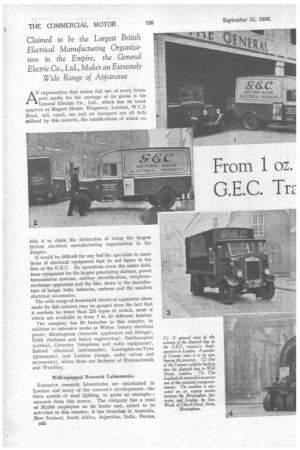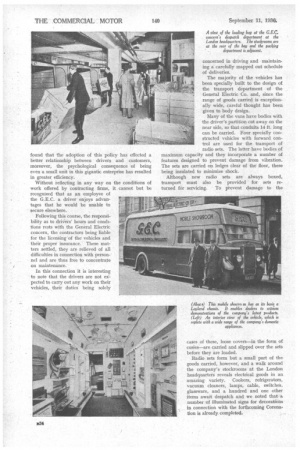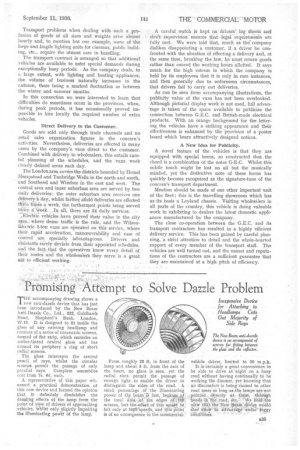From 1 oz.
Page 42

Page 43

Page 44

Page 45

If you've noticed an error in this article please click here to report it so we can fix it.
100 tons—
G.E.C. Problems
Claimed to be the Largest British Electrical Manufacturing Organization in the Empire, the General Electric Co., Ltd., Makes an Extremely
Wide Range of Apparatus
Road Transport, Operated Under Contract, is Used Extensively by the G.E.C. A Fleet of 120 Vans is Used for Effecting Deliveries in
London and the Provinces
ANorganization that makes full use of every transport media for the carriage of its goods is the General Electric Co., Ltd., which has its headquarters at Magnet House, Kingsway, London, W.C.2. Road, rail, canal, sea and air transport are all fully utilized by this concern, the ramifications of which en
title it to claim the distinction of being the largest British electrical manufacturing organization in the Empire.
It would be difficult for any but-the specialist to name items of electrical equipment that do not figure in the lists of the G.E.C. Its operations cover the entire field, from equipment for the largest generating stations, power transmission systems, railway electrification, telephoneexchangeapparatus and the like, down to the manufacture of lamps, bells, batteries, carbons and the smallest electrical accessories.
The wide range of household electrical apparatus alone made by this concern may be gauged from the fact that it markets no fewer than 255 types of switch, most of which are available in from 7 to 12 different finishes.
The company has 30 branches in this country, in addition to extensive works at Witton (heavy electrical plant), Birmingham (domestic appliances and fittings), • Erith (turbines and heavy engineering), Southampton (cables), Coventry (telephone and radio equipment), Salford (electrical instruments), Lemington-on-Tyne (glassware), and London (lamps, radio valves and accessories), where there are factories at Hammersmith and Wembley.
Well-equipped Research Laboratories.
Extensive research laboratories are maintained in London and many of the concern's developments—the Osira system of road lighting, to quote an example— emanate from this source. The company has a total of 33,000 employees on its books and, added to its activities in this country, it has branches in Australia, New Zealand, South Africa, Arkentina, India, Burma, D32 Malaya, China, France and HoIla.nd, together with agencies in all the principal cities of the world.
Such then is the G.E.C., and it will be appreciated that in the scope of this article it is possible to deal in detail with but a small part of the transport activities necessary to the efficient handling of the large volume of business which is transacted by the company.
As previously mentioned, the General Electric Co. makes the fullest use of every form of transport. Its policy is to choose, in every case, the particular service which is best suited to the traffic concerned. Naturally, road transport is used extensively and, although the company owns relatively few vehicles, a large fleet is operated under contract.
Befbre describing some of the special features of this fleet, which is run in connection with the delivery of goods in London and the provinces, it should be mentioned that on the heavy-engineering side, too, road vehicles are used to a great extent. The wide range of goods manufactured renders it impossible for the company to operate its own vehicles and this side of the transport organization is also carried out largely under contract with a number of haulage concerns.
Large Fleet of Delivery Vans.
Reverting to the fleet of delivery vehicles, this comprises 120 machines, about 40 of which are stationed in London. They are run under contract by the United Service Transport Co., Ltd., Pickfords, Ltd., Tilling, Ltd., the Metropolitan Supply Co., Ltd., and others.
Many of the vans are Commers, and Bedford, Morris, Austin and Wilson-Electric machines also figure amongst the makes operated. In the main, the capacity of the vans ranges from 10 cwt. to 30 cwt., but a few vehicles of larger pay-load are operated for special work.
A notable feature of the transport arrangements is that the drivers and assistants are all employees of the
• General Electric concern, and this system is one that has brought many advantages in its train. It has been B38
found that the adoption of this policy has effected a better relationship between drivers and customers, moreover, the psychological consequence of being even a small unit in this gigantic enterprise has resulted in greater efficiency.
Without reflecting in any way on the conditions of work offered by contracting firms, it cannot but be recognized that as an employee of the G.E.C. a driver enjoys advantages that he would be unable to secure elsewhere.
Following this course, the responsibility as to drivers' hours and conditions rests with the General Electric concern, the contractors being liable for the licensing of the vehicles and their proper insurance. ' These mat ters settled, they are relieved of all difficulties in connection with personnel and are thus free to concentrate on maintenance.
In this connection it is interesting to note that the drivers are not expected to carry out any work on their vehicles, their duties being solely concerned in driving and maintaining a carefully mapped out schedule of deliveries.
The majority of the vehicles has been specially built to the design of the transport department of the General Electric Co. and, since the range of goods carried is exceptionally wide, careful thought has been given to body design.
Many of the vans have bodies with the driver's partition cut away on the near side, so that conduits 14 ft. long can be carried. Four specially constructed vehicles with forward con-. trol are used for the transport of radio sets. The latter have bodies of maximum capacity and they incorporate a number of features designed to prevent damage from vibration. The sets are carried on ledges clear of the floor, these being insulated to minimize shock.
Although new radio sets are always boxed, transport must also be provided for sets returned for servicing. To prevent damage to the cases of these, loose covers—in the form of cosies—are carried and slipped over the sets before they are loaded.
Radio sets form but a small part of the goods carried, however, and a walk around the company's stockrooms at the London headquarters reveals electrical goods in an amazing variety. Cookers, refrigerators, vacuum cleaners, lamps, cable, switches, glassware, and a hundred and one other items await despatch and we noted that a. number of illuminated signs for decorations in connection with the forthcoming Coronation is already completed.
Transport problems when dealing with such a' pro-. fusion of goods of all sizes and weights arise almost hourly and, to mention but one example, some of the large and fragile lighting units for cinemas, public building, etc., require the utmost care in handling. .
The transport contract is arranged so that additional vehicles are available to meet special demands during exceptionally busy periods. As the company deals, to a large extent, with lighting and heating -appliances, the volume of business naturally increases in the autumn, there being a marked fluctuation as between the winter and summer months.
In this connection we were interested to learn that difficulties do sometimes occur in the provinces, when, during peak periods, it has occasionally proved impossible to hire locally the required number of extra vehicles.
Direct Delivery to the Customer.
Goods are sold, only through trade channels and no retail sales organization figures in the concern's activities. Nevertheless, deliveries are effected in many cases by the company's. vans direct to the customer. Combined with delivery to wholesalers, this entails careful planning of the schedules, and the vans work clearly defined areas each day.
The London area covers the districts bounded by Hemel Hempstead and Tunbridge Wells in the north and south, and Southend and Windsor in the east and west. The central area and inner suburban area are served by two daily deliveries ; the outer suburban area receives one delivery, a 'day, whilst farther afield deliveries are effected -t-tiii;e, times a week the farthermost Points being served twice a Week. In all there are 34 daily serVices.
„Electric vehicles have proved their value in the city where dense traffic is the rule, and the Wilsonlilectric 1-ton vans are operated on this service, where their rapid atCeleration, manceuvr-ability and ease of control are specially advantageous. Drivers and nSsistants rarely 'deviate from their appointed schedules, and the fact that the operatives know every detail Of their route; and the wholesalers they serveis a' great aid to effi.cient -working. • A careful watch is kept on' driv.ers' log sheets and strict supervision ensures that legal requirements are fully met. We were told that, much as the' company dislikes disappointing a customer, if a driver be confronted with the situation of effecting a delivery and, at the same time, breaking the law, he must return goods rather than exceed the working hours allotted. It says much for the high esteem in which the company is held by its employees that it is only in rare instances, and then generally due to unforeseen circumstances, that drivers fail to carry out deliveries.
As can be seen from accompanying illustrations, the publicity value of the vans has not been overlooked. Although pictorial display work is not used, full advantage is taken of the space available to publicize the connection between G.E.C. and British-made electrical products. With an orange background for the lettering the vehicles have a striking appearance and their effectiveness is enhanced by the provision of a poster board which bears attractively designed notices.
A New Idea for Publicity.
A novel feature of the vehicles is that they are equipped with special horns, so constructed that the chord is a combination of the notes G-E-C. Whilst this subtle touch might be lost on all but the musically minded, yet the distinctive note of these horns has quickly become recognized as the signature-tune of the concern's transport department.
Mention should be made of one other important unit of the fleet ; this is the travelling showroom which has as its basis a Leyland chassis. Visiting wholesalers in all parts of the country, this vehicle is doing valuable work in exhibiting to dealers the latest domestic appliances manufactured by the company.
The close co-operation between the G.E.C. and its transport contractors has resulted in a highly efficient delivery service. This has been gained by careful planning, a strict attention to detail and the whole-hearted support of every member of the transport staff. The vehicles are well turned outs and the names and reputations of the contractors are a sufficient guarantee that they are -maintained at a high pitch of efficiency.




















































































